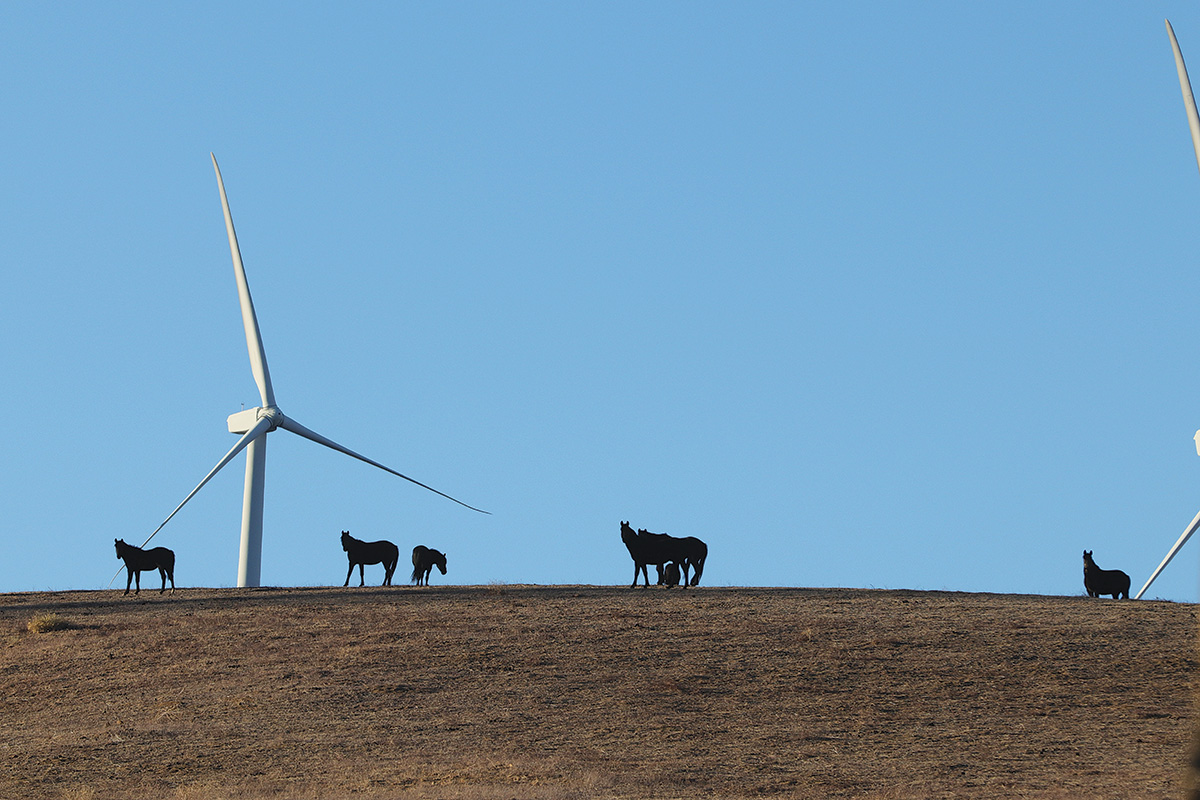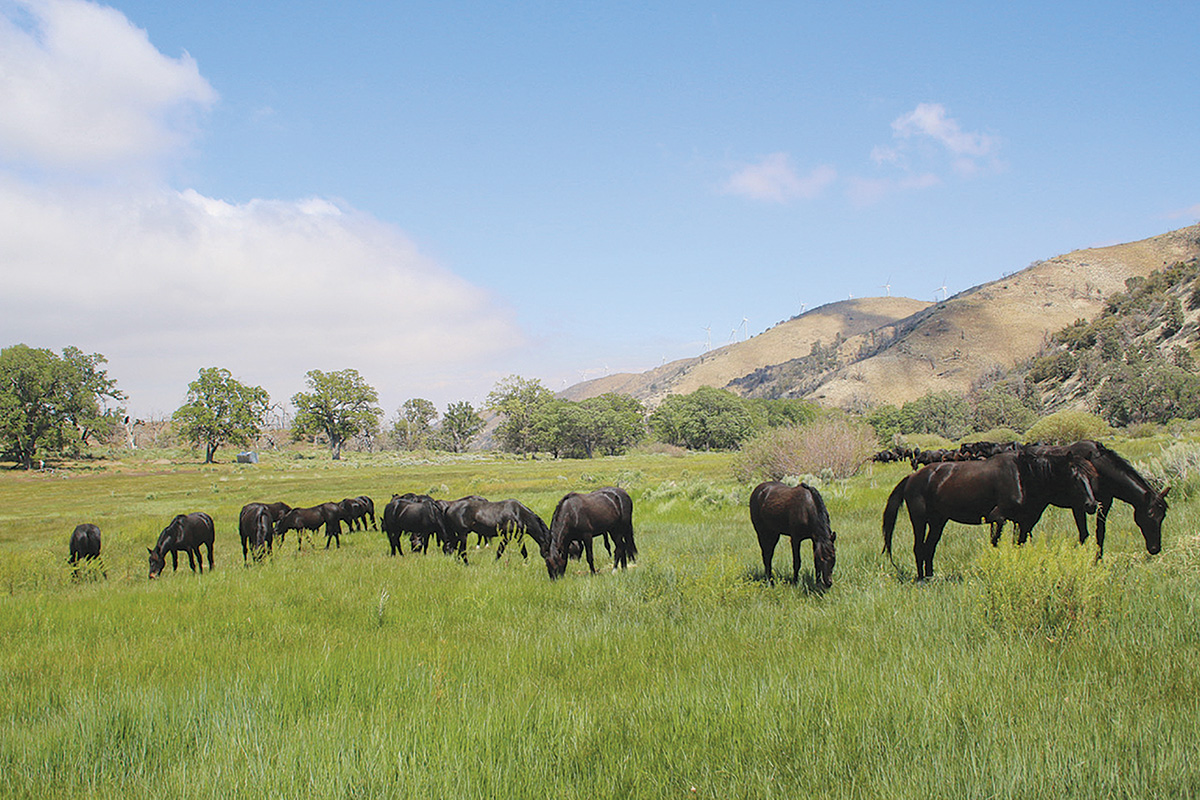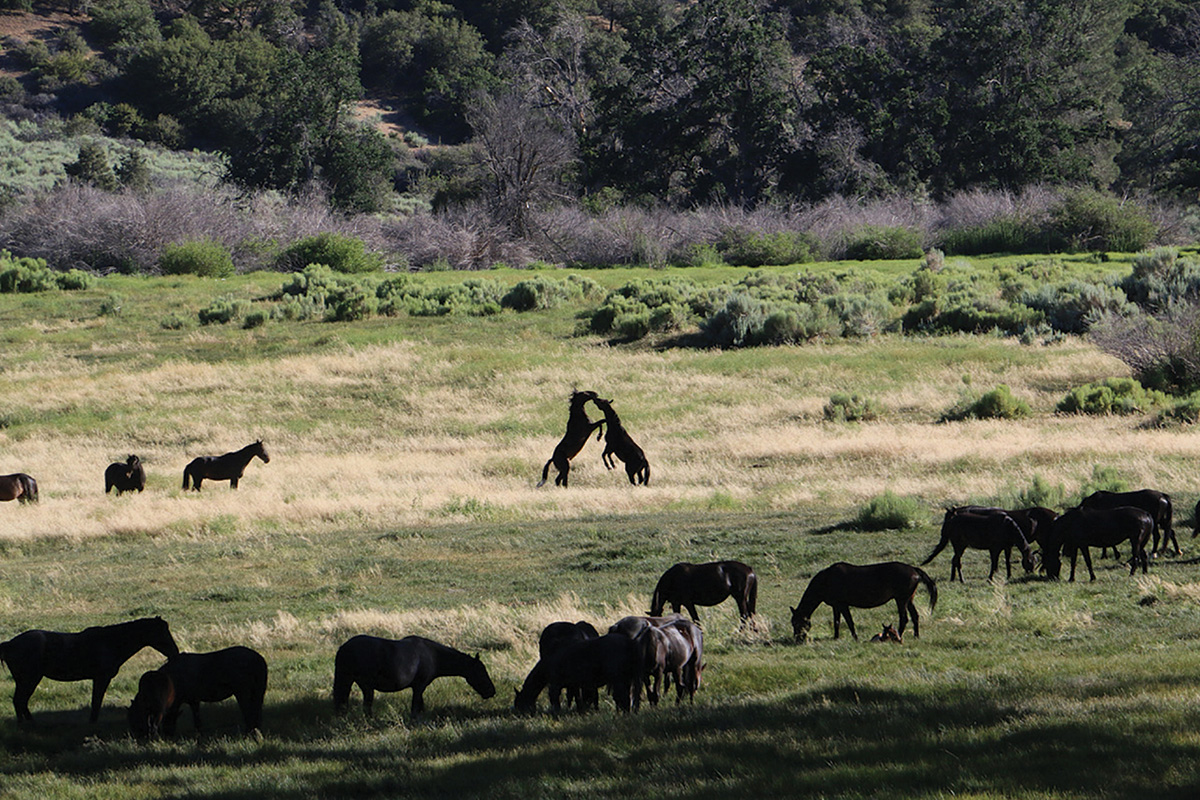
California is famous for Silicon Valley and world-changing technology, but not everything in California smacks of the 21st century. Deep in the Tehachapi Mountains of Central California alongside acres of giant wind turbines that provide electricity for thousands of residents throughout the state, there are living remnants of old California: the Oak Creek Horses.
History of the Oak Creek Horses
Take one look at an Oak Creek Horse and you can see a connection to the Morgan breed. Compact and muscular with short backs, round hindquarters, and strong heads with short ears—these are traits of the western working Morgan that proliferated Kern County cattle ranches in the 1800s and are evident in today’s Oak Creek Horses.

Although the exact origin of the Oak Creek Horses is not known—DNA tests on a small sampling of the herd were inconclusive—some experts believe the horses are descended from a group of black and brown Morgan horses that went missing from the records of the Tehachapi Land & Cattle Company, owned by Morgan breeder Roland Hill, in the early 1900s.
Morgan horse historian Brenda Tippin notes that six mares and five of their accompanying foals disappeared from the ranch’s records only two years after the horses arrived in Tehachapi from Texas, where they lived on a vast Morgan breeding ranch owned by Richard Sellman.
“When one considers that these mares came from running free on the vast ranges of Sellman’s Texas ranch and were turned out in California on Roland Hill’s equally vast ranges adjoining the Tehachapi mountains, it seems a likely possibility that some of the mares and colts may have escaped and were not recovered, and perhaps a few survived to form their own band,” Tippin wrote in 2015 in The Morgan Horse magazine in an article about the origins of the Oak Creek Horses.
The Horses’ Discovery
Residents of Kern County had been seeing the mysterious Oak Creek Horses for decades, grazing on hillsides and roaming through Oak Creek Canyon. It wasn’t until 1986 that the herd’s current manager, Diana Palmer, discovered these special horses living on land owned by a cement company.
“My husband Steve and I left the Los Angeles area and moved to Oak Creek Canyon in October of 1986,” she says. “We were contracted in Tehachapi as property caretakers for a landowner. We patrolled the property on a regular basis, maintained fences and roadways, and secured the property from trespassers. We would always see the wild horses roaming throughout.”

Over the years, Palmer noticed the herd size increase dramatically while the land become overgrazed.
“We noticed the horses were losing weight and were generally in poor health,” she says. “After meeting with the landowner about the horses and explaining the situation, we asked about managing the herd, and suggested we could try to catch some and find them homes.”
Palmer’s employer agreed. But helping the horses was not that easy. At first, the horses were too wild to accept Palmer’s offers of food.
“In the beginning, the horses wanted nothing to do with people, and they wouldn’t eat the hay we put out for them,” she says.
With the help of an old domestic gelding that was turned loose with the herd, the horses learned to trust people and eat the hay that was brought to them.
“We would take the gelding a flake of alfalfa from time to time,” Palmer says. “Eventually, a stallion in the herd came over to see what the gelding was eating. There was snow on the ground and not much forage.”
The horses began eating the hay, and soon came to rely on it.

Palmer’s management of the Oak Creek herd began in 2002. Nearly 20 years later, she is still watching over them, keeping the population to manageable levels and providing alfalfa during times of drought.
Palmer’s goal is to keep the herd down to a size that natural grazing will support. This means gelding the colts and finding homes for some of the babies that appear each spring.
“There is no set number of horses to adopt out each year,” Palmer says. “People who are interested in adopting one of these horses come and pick one out in the field. Then, when the horses are in the vicinity of the catch pen, we focus on catching that horse.”
Palmer screens potential adopters to make sure the horse will be going to a good home. Dozens of Oak Creek Horses have been adopted by local residents over the years, and some also live in other parts of California.
The Horses Today
Not surprisingly, Oak Creek Horses make incredible mounts. To help bring this truth to the attention of the local community, Palmer and trainer Jeremy Dunn hosted an event called the Vaquero Heritage Trainers’ Challenge in 2014 and 2015. The challenge was meant to showcase the horses’ disposition, temperament, and trainability.
The challenge offered local trainers an opportunity to select an Oak Creek wild horse to work with for several months and provide the horse with a solid foundation. The goal was

to display the trainer’s ability and the horse’s innate talent. Oak Creek Horses proved they could work in dressage, driving, and western disciplines, and negotiate an obstacle course.
While the challenge brought attention to the Oak Creek Horse’s natural abilities, those who have adopted these horses have been using their mounts in competitive events for years. Working equitation and competitive trail riding are two sports where Oak Creek Horses are regularly seen in Southern and Central California events. Of course, recreational trail riding is the activity of choice for Oak Creek Horses, who grew up in the hills of California.
Today the Oak Creek Horses are the unofficial mascots of the city of Tehachapi and are known and loved by many of the residents. The herd has become synonymous with the area, and even appears in a Southern California Edison television commercial highlighting the Tehachapi Pass wind turbines.
With the help of local veterinarians and other volunteers, Palmer continues to care for the Oak Creek Horses, providing supplemental hay, gelding colts, and finding homes for some of the younger horses. With Palmer’s help and the continued support of the residents of Tehachapi, the Oak Creek Horses will continue to live and thrive in their mountain home.
This article about the Oak Creek Horses appeared in the March 2022 issue of Horse Illustrated magazine. Click here to subscribe!





